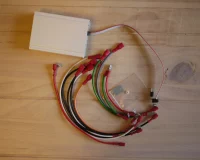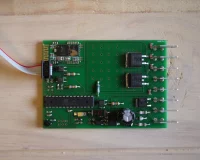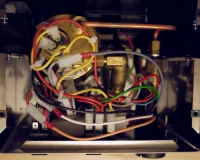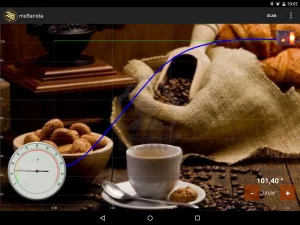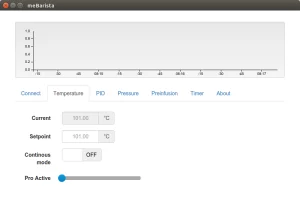The Rancilio Silvia Espresso Machine has one major weakness: the high fluctuation of the default thermostat.
The taste of the espresso already varies with temperature deviations as small as 1°C, but the thermostat of the Silvia V3, V4 has a range of ~20°C (~30°C for Silvia V1, V2).
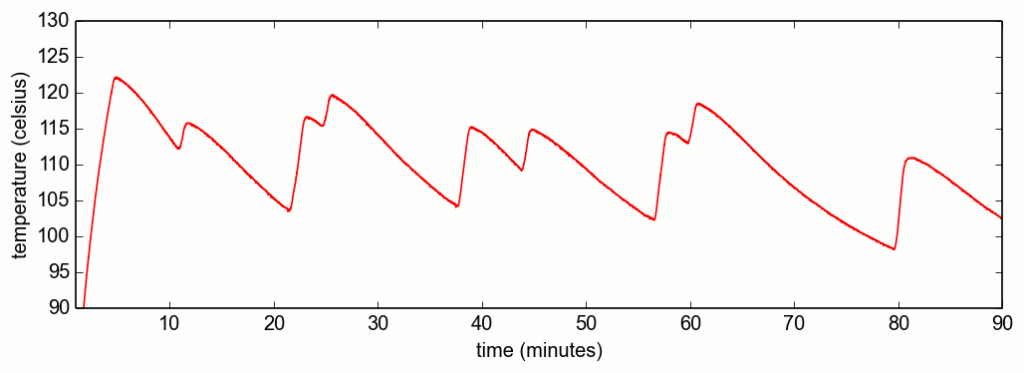
So to get a decent tasting espresso one need to predict the heating phase of the boiler, which is called temperature surfing. However this involves wasting water and one also needs the right timing which is especially difficult for beginners.
PID Controlled Temperature
A better solution to is to replace the default thermostat with a digital one. This means adding microcontroller that will monitor the temperature using the PID algorithm. This way you always have the right temperature – without surfing. Furthermore the microcontroller can be used to add some fancy features to the machine like preinfusion or a shot timer.
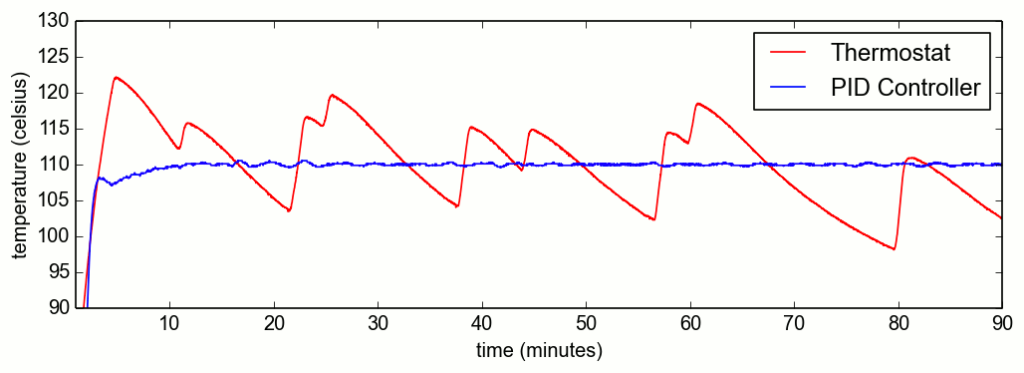
As the Silvia is a very popular machine, there are preconfigured kits available consisting of a microcontroller, a thermoelement and the necessary cabeling, so one only needs to open the machine and plug some cables.
The meCoffee PID Kit
The most recent and thus most modern one is the meCoffee Kit. It consists of a bluetooth enabled microcontroller that is installed inside the Silvia and the meBarista control app available for Android and Chrome.
There was a Kickstarter Campaign for the Kit. It promised to deliver the controller at a price of 119€ in September. Although the kickstarter failed, they still managed to keep the price of 119€ and are already delivering now. I would say this is still a success compared to the “successful” ZPM Espresso Machine kickstarter.
Installation
Inside the package you will find the controller, the housing and all required cables for installation inside the Rancilio Silvia. The presented kit contained version 5 of the meCoffee board.
On the board, which seems to be a custom version of an Arduino Uno, you find the ATmega328PU CPU and the HC05 Bluetooth Serial Transceiver as well as other parts necessary for PID operation.
Building a comparable setup using an Arduino would cost around 50-60€ just for the hardware – then one would still have to write the software. The custom printed PCB of meCoffee however is probably more expensive as it has to be produced in a small series.
Using the custom PCB has the advantage that everything is cleanly integrated on one small board – going with an Arduino one would need additional wiring to connect the components and thus end up with considerably larger package.
The installation is straightforward; it only requires removing the top cover of the Silvia and then plugging some wires. This process can be easily completed in about 45min.
Once installed the housing is placed below the power switch where it neatly hides without causing any cable clutter.
Usage
Using bluetooth to wirelessly control meCoffee is quite an elegant design compared to older Kits that use external display modules. One actually only needs the external display to configure the temperature and to monitor that everything works from time to time. For preparing an espresso, the thermostat LED gives you all the information you need.
To configure and to monitor the temperature on the other hand a smartphone or a Laptop are a much better choices. So leaving out a external display not only makes installation easier but also keeps the price down and improves usability.
One catch though is that the current Kit is not compatible with iOS. The HC05 Tranciever only supports Bluetooth 2.0, while Apple requires either using Bluetooth 4.0 Low Energy or buying a MFi license. However according to the Kickstarter page they are planning to release a Bluetooth 4.0 version in November for 149€.
Control apps are available for Android and Chrome – but as Chrome does not support Bluetooth on Linux, there is no Linux support for meCoffee. In general the Android app is more polished. For instance the shot timer and firmware update are currently only available on Android.
However there is no need to keep a smartphone around the coffe machine – the settings are stored inside meCoffee and the thermostat LED dims when the target temperature is reached.
Functionality
The main functionality of meCoffee is classical PID during coffee infusion aka brew control. As can be seen in the Screenshot below this works flawlessly. The average absolute temperature deviation is reduced to 0.25°C with a maximum deviation of 2.9°C.
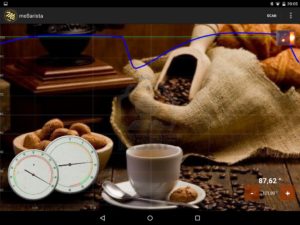
As you have the temperature sensor at your Boiler, meCoffee can also control the steam temperature. This one is actually also very useful. The default Silvia Thermostat heats up to 150°C for steaming which is way to much if you just want to prepare a single cappuccino. Therefore meCoffee by default tames it to a more sane 135°C. This is not purely altruistic however; looking at the specs of the meCoffee temperature sensor (LM35DT) 150°C are the upper limit of its operation range.
Next there is programmable pre-infusion for wetting the grind before brewing. This basically introduces a pause in the brewing process. I use the following settings; start the pump for 2 second, then wait for 5 seconds before continuing with brewing. This eliminated channeling in the puck for me.
Then there is a shot timer, which automatically starts as soon as you flip the brew-switch and displays whether your shot is in the recommended 20-25 seconds range.
Finally the Firmware can be easily updated using the Apps over Bluetooth. This way you can easily deploy new features and fixes without the need to taking out the board and attaching it to a PC.
The downside is that currently you actually have install updates, as the Apps and the firmware are still in active development. During the writing of this text a bug in the meBarista Android app was fixed that prevented heating up the boiler for steaming when changing the steam temperature. (available in the Beta version)
Alternatives
As already mentioned meCoffee is just the recent in a series of PID Kits available for the Rancilio Silvia.
Out of those the Arturo Kit probably comes closest to meCoffee. It is also supposed to be placed inside the machine and supports bluetooth (just 2.0 as well). Although no external LCD is required, the Kit was clearly designed with an external LCD display in mind. Many features rely on a display to be present and the available control app is just a Virtual LCD screen that forces you to use virtual buttons to navigate the same menus as when using a hardware LCD screen. Furthermore the app is written in Java and thus only works on PCs.
However the Hardware is more capable than meCoffee. The Kit is based around the ATmega1284P which has more memory and there is an additional ADC on the board that allows higher resolution temperature measurement. Furthermore you can attach more than 2 sensors which is the limit of meCoffe. The arturo Kit allows using up to 8 sensors and control the LEDs of the Silvia individually at the same time. The downside is that the basic – PID only – kit starts at 303€ which is already more than half of the price of the Rancilio Silvia.
Then there are the older external display only kits like Auber Instruments (Starting at 139€) and PID Silvia (Starting at 104€). While in a similar price range to meCoffee, these offer less features as those are not programmable micro-controllers at heart but rather fixed electronic circuits.
Verdict
Without a PID controller the Rancilio Silvia is like an untamed beast – it requires lots of skill to make it do what you want and even then it is unforgiving to mistakes.
The meCoffee Kit is able to tame the beast. It gives you fine grained control over the machine through a nice user interface.
This makes the machine much easier to use for beginners as the Apps show exactly what is going on and further assist with a shot timer (at least on Android).
Compared to other Kits, meCoffee offers by far the most value for the money – even just considering the pure hardware costs it is a good deal.
The installation instructions however are currently not quite clear and the software is in active development so you might run into bugs.
Furthermore the current version is not compatible with iOS. Ultimately the Kit has not matured yet. If you are able to deal with this, you can buy it today. Otherwise you should give the Kit some more months.
But consider that we have a chicken-egg problem here: If everybody waits until the kit matures, the kit will not be able to mature as not enough people will be using it..
Updated 26.08.2015
The installation manual was updated by meCoffee and is now easier to follow. The initial wording of this post was:
However the official installation manual is often ambiguous and lacks any images. The resulting double and triple-checking of every connection blows up the installation time to several hours. Hopefully meCoffee will improve the manual soon.
